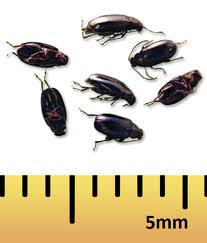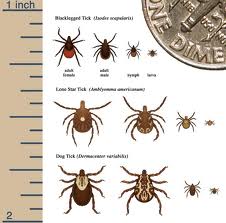 Animal Radio® Show #613 September 3, 2011 Animal Radio® Show #613 September 3, 2011
Why Are Fleas And Ticks So Bad This Year?
Dr. Mary A. Bryant, V.M.D., from Merial Field Veterinary Services
 Pet owners have a tendency to think that once the summer's over, flea & tick season is over too. But actually, as the weather turns cooler, there is usually an explosion. This is because fleas and ticks don't do very well in hot, dry weather. Pet owners have a tendency to think that once the summer's over, flea & tick season is over too. But actually, as the weather turns cooler, there is usually an explosion. This is because fleas and ticks don't do very well in hot, dry weather.
Both fleas and ticks can transmit disease. Even though it is not very common, fleas can transmit a disease to humans called Bartonellosis, which can cause fever, anemia and a skin rash. But ticks are another story. They can transmit many diseases. Even though all ticks look fairly similar, there are different species of ticks and they each carry different types of diseases. One of the most common diseases transmitted by ticks is the Lyme Disease, which can cause fever, headache, fatigue, depression and a characteristic circular skin rash called erythema migrans. Left untreated, later symptoms may involve the joints, heart, and central nervous system, which can be disabling and difficult to treat and can be fatal to both pets and people.
 So why are we seeing more of them this year? With ticks, they are occurring in new locations, they are becoming more active throughout the year and the sheer numbers of ticks are significantly higher. So why are we seeing more of them this year? With ticks, they are occurring in new locations, they are becoming more active throughout the year and the sheer numbers of ticks are significantly higher.
As a pet owner, you need to be more pro-active then re-active. This means that if you see a flea or tick on your pet and then run to your veterinarian for treatment – don't wait! Go to your vet first - before you even see that first flea or tick. The best preventative for your pet is for you to apply monthly spot on products to prevent fleas and ticks. If you do see these critters, you need to treat more than just your pet. You will need to treat your home, yard and even your car if they are transported to your vet. It can take months and months, more than just one treatment, to clear your home from these unwanted critters. While you can kill the adult fleas on your dog, you really have to worry about the life stages of fleas. The eggs, larva and pupa can live in your carpet for extended periods of time.
Your veterinarian sees hundreds of cases each week and really knows the geography of your area. They know what species of ticks they are seeing, when they are seeing them and what diseases they carry. They can then tell pet owners what products they should use. Some products are for fleas only, so be sure to talk about ticks as well, if this is a problem in your part of the country, or if you will be traveling with your pet.
"Get Your Licks on Route 66" Adoption Tour 2011
The Cross-Country Adoption Tour!
 Join FIDO Friendly® magazine and the Animal League as they team up for the 3rd Annual "Get Your Licks on Route 66" national mobile adoption tour. Join FIDO Friendly® magazine and the Animal League as they team up for the 3rd Annual "Get Your Licks on Route 66" national mobile adoption tour.
This life-saving tour kicks-off on September 7, 2011 and travels across the US to raise awareness of the importance of adopting a pet from a shelter. Get Your Licks on Route 66 will achieve its mission to save lives through 16 events in the following states: Arizona, California, Colorado, Illinois, Kentucky, Missouri, New Mexico, New York, Oklahoma, Texas, and Utah.
One lucky adopted pup will be featured in an upcoming issue of FIDO Friendly® magazine!
About the Tour
Check for updates and track our mobile rescue and adoption unit at these web sites:
http://www.blog.fidofriendly.com
http://www.AnimalLeague.org
http://www.animalleague.org
The Dogfather's Grooming Tip with Joey Villani
 Your Groomer May Notice Things That You Don't! Your Groomer May Notice Things That You Don't!
Joey has been getting some complaints from groomers stating that he only talks about the negative side of the business. This time he talks about the importance of your professional groomer, who can do so much more than just give your pet a haircut.
Next to the general family, your groomer will see your dog more than anyone else, including your veterinarian or trainer. This means that they are able to notice things on your pet that you may not. This is because there are certain things that a groomer does that you don't do at home. For example, checking your dog's private area. You might not notice if there are any growths or irritation, or just things that shouldn't be there. But your groomer thoroughly cleans this area and would be the first to notice any thing wrong. Also checking your dog's ears. Your groomer might notice if there are any odd smells which could be the start of an ear infection and can then recommend you take your dog to the veterinarian.
J oey tells a story of when he was a child working with a groomer who was clipping the hair between a dog's toes. When the groomer squeezed down on the pad, a toothpick about 1.4 inch long, pushed through the skin and out from between the toes. When the owners came to pick the dog up, they were so thankful because the dog had been limping for quite some time and even x-rays done by their veterinarian couldn't pick it up. oey tells a story of when he was a child working with a groomer who was clipping the hair between a dog's toes. When the groomer squeezed down on the pad, a toothpick about 1.4 inch long, pushed through the skin and out from between the toes. When the owners came to pick the dog up, they were so thankful because the dog had been limping for quite some time and even x-rays done by their veterinarian couldn't pick it up.
Many times over the years, Joey has had many clients who have personally thanked him for finding things on their dogs, even growths, which signified the early signs of cancer.
So, by going to your professional groomer every 4 to 6 weeks, your dog will receive a body check as well!
 DOGFATHER'S GROOMING TIP Brought To You By SeniorPetProducts.com. Use the code "SAVE25" to receive 25 DOGFATHER'S GROOMING TIP Brought To You By SeniorPetProducts.com. Use the code "SAVE25" to receive 25
Animal Radio® News with Stacey Cohen
 Fat Dogs Tend To Be Colder Than Lean Canines Fat Dogs Tend To Be Colder Than Lean Canines
Fat dogs tend to be colder than lean canines, according to a new study that identifies a possible relationship between weight gain and body temperature. The findings, recently published in the International Journal of Obesity, could apply to humans and other mammals as well, according to the authors. Individuals who have a tendency to be cold may therefore be more susceptible to weight gain. The entire process appears to happen internally, so you can't just enjoy that extra dessert with the "I'm cold" excuse. Roberto Refinetti, a Professor of Psychology and Associate Dean at the University of South Carolina Salkehatchie, led the study. "We don't fully know the causes of the obesity epidemic that the U.S. is experiencing," he said in a press release. "One possible cause that hasn't been studied is the relationship between a lower body temperature and obesity." He and his team compared the rectal temperatures of 287 lean and obese dogs over several years. They found that larger dogs have lower temperatures than smaller dogs. Since size can be tied to the particular breed of dog and other factors, the scientists next focused on weight. They determined that, among canines of the same height and length, obese dogs have lower temperatures than lean dogs.
 California May Be Passing The Chips - Micro Type That Is California May Be Passing The Chips - Micro Type That Is
A statewide pet microchip law clears the State Senate and is headed for a vote by the Assembly. The law sponsored by Senator Ted Lieu would require owners of either dogs or cats to have their pets implanted with the tiny chips. Lieu said that studies show that three-out-of-every-four lost pets embedded with a microchip is reunited with their owners. Without the device, just one-in-ten pets find their way back home.
Car Thief Returns Vehicle With Children And Dog
A car thief who inadvertently scooped up a minivan with two kids and a poodle inside dropped the kids — and the car — at their home in Queens after the children scolded him for trying to raid the change tray. The father of the two boys in the would-be stolen van, Sebastian Russo, tells The New York Post the fracas began when he parked his car outside a store on Cross Bay Boulevard to buy a leash for his toy poodle, Colette. He left the vehicle running. Shortly after Russo entered the store, another man ran in and told him his van had been stolen. "I panicked and ran out and flagged down a police car," Russo told the paper. Russo and the officer commenced a frantic search for the children, but it was soon called off when Russo’s wife called and told him the van was in their driveway. The would-be car thief, frustrated by the lack of change in the change tray and the constant yapping of Colette the poodle, asked the kids their address, and dropped them off at home, reports the Post. Then the thief, who told the kids his name was "Leo," ambled off down their street with his shirt over his face. "I’m actually very thankful that he brought them home," Russo told the Post. "How mad can we be at him? He returned the car. He told my son, ‘If you weren’t in the car, I would’ve taken it.’"
 Can You Solve The Problem Of Pet Over Population? Can You Solve The Problem Of Pet Over Population?
Can you solve the problem of pet over population? If so, you could win a 25 million dollar prize! Across the world, scientists from more than a dozen institutions are harnessing cutting-edge technology to develop a non-surgical sterilant for dogs and cats. They hope their innovative experiments will pay off in two ways: 1) Solve the problem of pet overpopulation, and 2) Secure a $25 million prize. In 2008, Found Animals Foundation announced the launch of its unique Michelson Prize & Grants Program, named after Found Animals' creator Dr. Gary Michelson, a billionaire orthopedic spinal surgeon who wants to see a decrease in the 4+ million animals euthanized each year in U.S. shelters. In addition to the $25 million incentive to the first person to successfully develop a nonsurgical method for sterilizing cats and dogs, the Michelson Grants in Reproductive Biology offers a maximum of $50 million in funding for promising research in pursuit of non-surgical sterilization technology.
Dinner Dogs Spared
More than a thousand dogs headed for the dinner table were spared when Thai authorities uncovered a massive dog smuggling operation. Jammed into crowded cages at the Nakhon Phanom Animal Quarantine Station, the future of the dogs is still in question, but officials hope to send a strong message to would-be smugglers. Three suspects now face charges including unlicensed trade in animals, illegal transport of animals, transport of dogs to an area under rabies monitoring, cruelty to animals and violation of vaccination law, among others. According to Nakhon Phanom Governor Rerngsak Mahawinijchaimontree, "Police believe all the dogs would have been transferred to a ship waiting in Ban Phaeng district of Nakhon Phanom before going across the Mekong River to be sold in Vietnam, where lots of dogs are ordered to be cooked as famous exotic dishes."
 Can Your Pet Do This? Can Your Pet Do This?
Dog owners love to boast about the abilities of their canine pals, but not many can say their pet can add and subtract. A Labrador Retriever in Montana named Beau can also reportedly "do some division and has memorized square roots." Owner David Madsen says the pooch gives his answers in the correct number of woofs. Madsen says he began honing Beau's math skills when he was a puppy and taught him to count using dog biscuits. The Lab has become a local celebrity in the Montana resort town where his family spends the summer. Beau visits shops, restaurants and cabins demonstrating his unusual abilities.
 NEWS UPDATE Brought To You By PetzLife.com. Use the code "RADIO" to receive 20% off! NEWS UPDATE Brought To You By PetzLife.com. Use the code "RADIO" to receive 20% off!
 Listen to the
entire Podcast of this show (#613) Listen to the
entire Podcast of this show (#613)
 indicates XM Satellite Radio and Podcast versions
only. indicates XM Satellite Radio and Podcast versions
only.
|

 Pet owners have a tendency to think that once the summer's over, flea & tick season is over too. But actually, as the weather turns cooler, there is usually an explosion. This is because fleas and ticks don't do very well in hot, dry weather.
Pet owners have a tendency to think that once the summer's over, flea & tick season is over too. But actually, as the weather turns cooler, there is usually an explosion. This is because fleas and ticks don't do very well in hot, dry weather.  So why are we seeing more of them this year? With ticks, they are occurring in new locations, they are becoming more active throughout the year and the sheer numbers of ticks are significantly higher.
So why are we seeing more of them this year? With ticks, they are occurring in new locations, they are becoming more active throughout the year and the sheer numbers of ticks are significantly higher.

 oey tells a story of when he was a child working with a groomer who was clipping the hair between a dog's toes. When the groomer squeezed down on the pad, a toothpick about 1.4 inch long, pushed through the skin and out from between the toes. When the owners came to pick the dog up, they were so thankful because the dog had been limping for quite some time and even x-rays done by their veterinarian couldn't pick it up.
oey tells a story of when he was a child working with a groomer who was clipping the hair between a dog's toes. When the groomer squeezed down on the pad, a toothpick about 1.4 inch long, pushed through the skin and out from between the toes. When the owners came to pick the dog up, they were so thankful because the dog had been limping for quite some time and even x-rays done by their veterinarian couldn't pick it up.
 Fat Dogs Tend To Be Colder Than Lean Canines
Fat Dogs Tend To Be Colder Than Lean Canines California May Be Passing The Chips - Micro Type That Is
California May Be Passing The Chips - Micro Type That Is Can You Solve The Problem Of Pet Over Population?
Can You Solve The Problem Of Pet Over Population? Can Your Pet Do This?
Can Your Pet Do This?